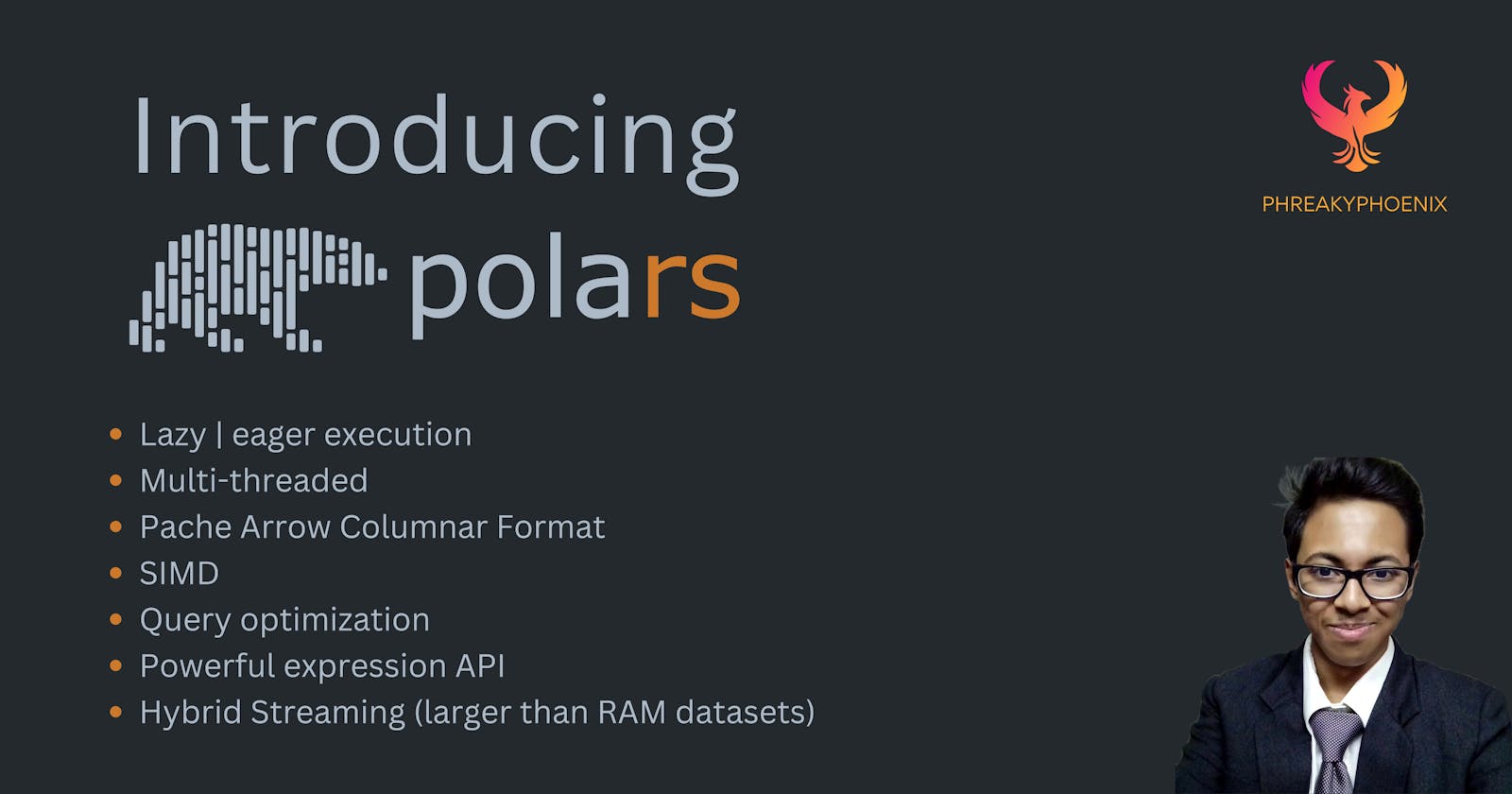Introducing Polars
Multi-threaded dataframe manipulation in columnar format with Rust
As data scientists, we are constantly searching for tools that will enable us to manipulate and analyze large datasets efficiently. Pandas is the most widely used tool in the data science community for data manipulation and analysis, and it has been for a long time. However, as datasets become larger and more complex, pandas can become a bottleneck in the data processing pipeline, especially when dealing with time-series data. In this blog post, we will explore a new data manipulation library, Polars, that aims to provide fast and memory-efficient data manipulation and analysis. We will discuss the key features of Polars and compare it with pandas to see how it stacks up in terms of performance, ease of use, and functionality.
What is Polars?
Polars is a new data manipulation library built for Rust, a system programming language that prioritizes safety, speed, and concurrency. Rust is known for its memory safety and speed, making it an excellent choice for building a high-performance data manipulation library like Polars. Polars provides a DataFrame API that is similar to pandas, but with some key differences that make it more efficient and faster for large datasets. Polars can handle large datasets, even if they don't fit into memory, by utilizing lazy evaluation and chunking. It also provides support for time-series data, which can be challenging to handle efficiently in pandas.
Key Features of Polars:
Lazy evaluation: Polars utilizes lazy evaluation to avoid unnecessary computations, which can save a lot of time and memory when working with large datasets. Lazy evaluation is a technique used to delay the computation of an expression until it is needed. This means that Polars will not compute any operation until it is necessary, which reduces the memory footprint of the operation.
Chunking: Polars can handle datasets that do not fit into memory by chunking the data into smaller pieces. This allows Polars to perform operations on each chunk separately, reducing the memory usage of the operation. The result is that Polars can handle larger datasets than pandas, even if they do not fit into memory.
Time-series support: Polars provides excellent support for time-series data, which can be challenging to handle efficiently in pandas. Polars provides time-series specific operations, such as rolling and resampling, that are optimized for speed and memory usage.
Parallelism: Polars is designed to take advantage of modern CPUs with multiple cores. It can use all available CPU cores to perform operations in parallel, making it faster than pandas in many cases.
Rust memory safety: Rust provides memory safety by preventing memory errors such as buffer overflows and null pointer dereferences. This makes Polars a safe and reliable library to use.
Comparing Polars and Pandas:
Performance: Polars is faster than pandas for many operations, especially when dealing with large datasets. Polars achieves this performance improvement by utilizing lazy evaluation, chunking, and parallelism. This means that Polars can handle larger datasets and perform operations faster than pandas in many cases.
Memory usage: Polars uses less memory than pandas, especially when dealing with large datasets. This is because Polars uses lazy evaluation and chunking to reduce the memory footprint of operations.
Ease of use: Polars has a similar API to pandas, so it is easy to use for those familiar with pandas. However, some operations may require a different approach in Polars, so there may be a learning curve for some users.
Functionality: Polars has a similar set of functionality as pandas, with some differences due to the design choices made by the developers. However, Polars provides excellent support for time-series data, which can be challenging to handle in pandas.
As a data scientist, you are constantly dealing with large datasets, and performing complex data manipulation tasks. In order to perform these tasks efficiently, you need to use the right tools. Two of the most popular tools for data manipulation are Pandas and Polars. In this blog, we will take a look at Polars and compare it to Pandas, and explore the benefits and drawbacks of using each tool.
Introduction to Polars
Polars is a Rust-based data manipulation library that aims to be a faster, safer and more ergonomic alternative to Pandas. It is designed to handle large datasets efficiently, with minimal memory usage, and provides an expressive API for data manipulation. The Polars library is built on top of Apache Arrow, which allows it to efficiently handle large datasets in a distributed environment.
Key Differences between Polars and Pandas
Both Polars and Pandas are powerful tools for data manipulation, but they have some key differences that may make one a better fit for your use case. Here are some of the key differences:
Performance
One of the key advantages of Polars over Pandas is its performance. Polars is designed to be faster and more memory-efficient than Pandas. This is because it is written in Rust, which is a faster language than Python. Additionally, Polars uses Apache Arrow to store data in a columnar format, which is more memory-efficient than the row-based format used by Pandas. In benchmarks, Polars has been shown to be up to 50 times faster than Pandas for certain operations.
Memory Usage
Polars uses a columnar format to store data, which can be more memory-efficient than the row-based format used by Pandas. This is because columnar storage allows for better compression and can reduce the amount of memory needed to store data. Additionally, Polars uses lazy evaluation, which means that it only computes operations when they are needed, which can further reduce memory usage.
API
Both Polars and Pandas have powerful APIs for data manipulation. However, the two libraries have some key differences in their APIs. Polars has a more concise API that is designed to be more ergonomic than Pandas. Additionally, Polars supports method chaining, which allows you to chain together multiple operations in a single expression. This can make code more readable and concise.
Language
Polars is written in Rust, which is a faster language than Python. Pandas is written in Python, which is a popular language for data science. While Rust may be faster than Python, it may be harder to learn than Python, especially if you are new to programming.
Compatibility
While Polars has a similar API to pandas, there are some differences in how operations are performed that may require a different approach. However, these differences are minor and should not be a significant barrier to entry for users familiar with pandas. But using proper Polars syntax is the best way to leverage it to it's fullest
In conclusion, Polars is an excellent alternative to pandas for data manipulation and analysis, especially when dealing with large datasets. Its focus on memory efficiency, speed, and support for time-series data make it a valuable addition to any data scientist's toolbox.
Here are some of the differences between Polars and Pandas against the key features:
| Feature | Polars | Pandas |
| Language | Rust | Python |
| Memory usage | Uses less memory, especially when dealing with large datasets. | Can use a lot of memory, especially when dealing with large datasets. |
| Performance | Faster than pandas for many operations, especially when dealing with large datasets. | Slower than Polars for large datasets and some operations. |
| Lazy evaluation | Utilizes lazy evaluation to avoid unnecessary computations, reducing memory usage. | Does not utilize lazy evaluation, which can lead to unnecessary computations and increased memory usage. |
| Chunking | Can handle datasets that do not fit into memory by chunking the data into smaller pieces. | Cannot handle datasets that do not fit into memory without additional tools like Dask or Vaex. |
| Time-series support | Provides excellent support for time-series data, including time-series specific operations. | Supports time-series data, but lacks some of the time-series specific operations provided by Polars. |
| Parallelism | Designed to take advantage of modern CPUs with multiple cores. | Does not utilize parallelism by default. |
Overall, Polars provides better memory efficiency and performance for large datasets, but requires some additional learning for users familiar with pandas. However, for users working with time-series data or dealing with memory constraints, Polars may be the better choice. If you're not working with over 1M datasets, from my experience, using one vs the other does not have significant differences. Polars does have much faster filtering and reshaping in general. To know more about the performance comparison, stay tuned for the next article.

